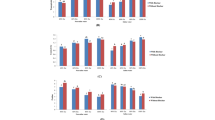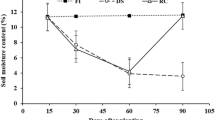Abstract
Drought has become an increasing problem in agriculture in recent years with fresh water becoming a scarce resource. One of the solutions to potentially alleviate detrimental effects of drought is the use of commercial seaweed-based biostimulants. The aim was to better understand their effects. Tomato plants (Solanum lycopersicum L.) were grown in soil under drought stress conditions with a 40% reduction in irrigation compared to control plants in 2020, and a 67% reduction in 2021. Plant responses to (i) drought stress, and (ii) a combination of drought stress and application of four selected seaweed biostimulants were continuously measured with sap flow and stem diameter variation sensors and compared to well-watered plants in each year. No differences were observed in overall yield and fruit size between treatments, indicating a potential water saving of at least 40% as confirmed by the sap flow measurements. Although no differences were observed in yield, some of the tested biostimulants did impact plant functioning. The Ascophyllum nodosum-based biostimulant resulted in water uptake during drought comparable to well-watered control plants, whilst the Saccharina latissimi-based biostimulant resulted in significantly lower water uptake than stressed control plants but with comparable yield as well-watered plants, increasing plant water-use efficiency. Therefore the recommendation is to use plant sensors for future objective quantification of water use and growth effects of featured biostimulants, and as part of the experiments to unravel modes of action of different biostimulants in crops.







Similar content being viewed by others
Data Availability
Available on request.
References
Allen RG, Pereira, LS, Raes,D (1998). Crop evapotranspiration - Guidelines for computing crop water requirements - FAO Irrigation and drainage paper 56. In scscourt.org. https://www.scscourt.org/complexcivil/105CV049053/volume3/172618e_5xAGWAx8.pdf
Battacharyya D, Babgohari MZ, Rathor P, Prithiviraj B (2015) Seaweed extracts as biostimulants in horticulture. Sci Hortic 196:39–48. https://doi.org/10.1016/J.SCIENTA.2015.09.012
Chaves MM, Oliveira MM (2004) Mechanisms underlying plant resilience to water deficits: prospects for water-saving agriculture. J Exp Bot 55(407):2365–2384. https://doi.org/10.1093/JXB/ERH269
Ciais P, Reichstein M, Viovy N, Granier A, Ogée J, Allard V, Aubinet M, Buchmann N, Bernhofer C, Carrara A, Chevallier F, De Noblet N, Friend AD, Friedlingstein P, Grünwald T, Heinesch B, Keronen P, Knohl A, Krinner G, Valentini R (2005) Europe-wide reduction in primary productivity caused by the heat and drought in 2003. Nature 437(7058):529–533. https://doi.org/10.1038/nature03972
Critchley AT, Critchley JSC, Norrie J, Gupta S, Van Staden J (2021) Perspectives on the global biostimulant market. Biostimulants for Crops from Seed Germination to Plant Development. Academic Press, Cambridge, pp 289–296. https://doi.org/10.1016/b978-0-12-823048-0.00012-5
Dai A (2011) Drought under global warming: a review. Wiley Interdiscip Rev: Climate Change 2(1):45–65. https://doi.org/10.1002/WCC.81
De Swaef T, Steppe K (2010) Linking stem diameter variations to sap flow, turgor and water potential in tomato. Funct Plant Biol 37(5):429–438. https://doi.org/10.1071/FP09233
De Swaef T, De Schepper V, Vandegehuchte MW, Steppe K (2015) Stem diameter variations as a versatile research tool in ecophysiology. Tree Physiol 35(10):1047–1061. https://doi.org/10.1093/treephys/tpv080
du Jardin P (2015) Plant biostimulants: definition, concept, main categories and regulation. Sci Hortic 196:3–14. https://doi.org/10.1016/J.SCIENTA.2015.09.021
Elansary HO, Yessoufou K, Abdel-Hamid AME, El-Esawi MA, Ali HM, Elshikh MS (2017) Seaweed extracts enhance salam turfgrass performance during prolonged irrigation intervals and saline shock. Front Plant Sci. https://doi.org/10.3389/FPLS.2017.00830
EUR-Lex - 32019R1009 - EN - EUR-Lex. (2019). Official Journal of the European Union. https://eur-lex.europa.eu/legal-content/EN/TXT/?qid=1583934899523&uri=CELEX:32019R1009
Fernández JE, Cuevas MV (2010) Irrigation scheduling from stem diameter variations: a review. Agric Forest Meteorol 150(2):135–151. https://doi.org/10.1016/j.agrformet.2009.11.006
Gallardo M, Thompson RB, Valdez LC, Fernández MD (2006) Use of stem diameter variations to detect plant water stress in tomato. Irrig Sci 24(4):241–255. https://doi.org/10.1007/s00271-005-0025-5
Goldhamer DA, Fereres E (2001) Irrigation scheduling protocols using continuously recorded trunk diameter measurements. Irrig Sci 20(3):115–125. https://doi.org/10.1007/S002710000034
Goñi O, Quille P, O’Connell S (2018) Ascophyllum nodosum extract biostimulants and their role in enhancing tolerance to drought stress in tomato plants. Plant Physiol Biochem 126:63–73. https://doi.org/10.1016/J.PLAPHY.2018.02.024
Hanssens J, De Swaef T, Steppe K, Goen K, De Nayer F, Wittemans L, Marien H, Desmedt J (2012) Effect of stem age on the response of stem diameter variations to plant water status in tomato. Acta Horticu 952:907–914. https://doi.org/10.17660/ACTAHORTIC.2012.952.115
Hanssens Jochen, De Swaef T, Nadezhdina N, Steppe K (2013) Measurement of sap flow dynamics through the tomato peduncle using a non-invasive sensor based on the heat field deformation method. Acta Hortic 991:409–416. https://doi.org/10.17660/ActaHortic.2013.991.50
IPCC. (2021). Sixth Assessment Report. In Global Warming of 1.5°C. An IPCC Special Report on the impacts of global warming of 1.5°C above pre-industrial levels and related global greenhouse gas emission pathways, in the context of strengthening the global response to the threat of climate change, (Vol. 2021, Issue August). https://www.ipcc.ch/report/ar6/wg1/
Jones HG (2004) Irrigation scheduling: advantages and pitfalls of plant-based methods. J Exp Bot 55(407):2427–2436. https://doi.org/10.1093/JXB/ERH213
Khan W, Rayirath UP, Subramanian S, Jithesh MN, Rayorath P, Hodges DM, Critchley AT, Craigie JS, Norrie J, Prithiviraj B (2009) Seaweed extracts as biostimulants of plant growth and development. J Plant Growth Regul 28(4):386–399. https://doi.org/10.1007/S00344-009-9103-X
Leonardi C, Guichard S, Bertin N (2000) High vapour pressure deficit influences growth, transpiration and quality of tomato fruits. Sci Hortic 84(3–4):285–296. https://doi.org/10.1016/S0304-4238(99)00127-2
Lipiec J, Doussan C, Nosalewicz A, Kondracka K (2013) Effect of drought and heat stresses on plant growth and yield: a review. Int Agrophys, Sciendo/de Gruyter 27(4):463–477. https://doi.org/10.2478/intag-2013-0017ï
Lockhart JA (1965) An analysis of irreversible plant cell elongation. J Theor Biol 8(2):264–275. https://doi.org/10.1016/0022-5193(65)90077-9
Markets M (2021). Biostimulants market global outlook, trends, and forecast to 2026 | MarketsandMarkets. https://www.marketsandmarkets.com/Market-Reports/biostimulant-market-1081.html
Moriana A, Pérez-López D, Prieto MH, Ramírez-Santa-Pau M, Pérez-Rodriguez JM (2012) Midday stem water potential as a useful tool for estimating irrigation requirements in olive trees. Agric Water Manag 112:43–54. https://doi.org/10.1016/j.agwat.2012.06.003
Omidbakhshfard MA, Sujeeth N, Gupta S, Omranian N, Guinan KJ, Brotman Y, Nikoloski Z, Fernie AR, Mueller-Roeber B, Gechev TS (2020) A biostimulant obtained from the seaweed Ascophyllum nodosum protects Arabidopsis thaliana from severe oxidative stress. Int J Mol Sci 21(2):474. https://doi.org/10.3390/IJMS21020474
Ortuño MF, Brito JJ, García-Orellana Y, Conejero W, Torrecillas A (2009) Maximum daily trunk shrinkage and stem water potential reference equations for irrigation scheduling of lemon trees. Irrig Sci 27(2):121–127. https://doi.org/10.1007/s00271-008-0126-z
Ortuño MF, Conejero W, Moreno F, Moriana A, Intrigliolo DS, Biel C, Mellisho CD, Pérez-Pastor A, Domingo R, Ruiz-Sánchez MC, Casadesus J, Bonany J, Torrecillas A (2010) Could trunk diameter sensors be used in woody crops for irrigation scheduling? A review of current knowledge and future perspectives. Agricu Water Manag 97(1):1–11. https://doi.org/10.1016/j.agwat.2009.09.008
Pereira LS, Oweis T, Zairi A (2002) Irrigation management under water scarcity. Agric Water Manag 57(3):175–206. https://doi.org/10.1016/S0378-3774(02)00075-6
Sharma HSS, Fleming C, Selby C, Rao JR, Martin T (2013) Plant biostimulants: a review on the processing of macroalgae and use of extracts for crop management to reduce abiotic and biotic stresses. J Appl Phycol 26(1):465–490. https://doi.org/10.1007/S10811-013-0101-9
Smith DM, Allen SJ (1996) Measurement of sap flow in plant stems. J Exp Bot 47(12):1833–1844. https://doi.org/10.1093/JXB/47.12.1833
Spann TM, Little HA (2011) Applications of a commercial extract of the brown seaweed Ascophyllum nodosum increases drought tolerance in container-grown ‘Hamlin’ sweet orange nursery trees. HortScience 46(4):577–582. https://doi.org/10.21273/HORTSCI.46.4.577
Spinoni J, Vogt JV, Naumann G, Barbosa P, Dosio A (2018) Will drought events become more frequent and severe in Europe? Int J Climatol 38(4):1718–1736. https://doi.org/10.1002/JOC.5291
Steppe K, De Pauw DJW, Lemeur R, Vanrolleghem PA (2006) A mathematical model linking tree sap flow dynamics to daily stem diameter fluctuations and radial stem growth. Tree Physiol 26(3):257–273. https://doi.org/10.1093/TREEPHYS/26.3.257
Steppe K, De Pauw DJW, Lemeur R (2008) A step towards new irrigation scheduling strategies using plant-based measurements and mathematical modelling. Irrig Sci 26(6):505–517. https://doi.org/10.1007/S00271-008-0111-6
Steppe K, Sterck F, Deslauriers A (2015) Diel growth dynamics in tree stems: linking anatomy and ecophysiology. Trends Plant Sci 20(6):335–343. https://doi.org/10.1016/j.tplants.2015.03.015
Van de Put H, Steppe K (2021) Automated detection of atmospheric and soil drought stress in Ficus benjamina using stem diameter measurements and modelling. Irrig Sci 1:1–15. https://doi.org/10.1007/s00271-021-00757-9
Vandegehuchte MW, Steppe K (2013) Corrigendum to: Sap-flux density measurement methods: working principles and applicability. Funct Plant Biol 40(10):1088. https://doi.org/10.1071/fp12233_co
Xu C, Leskovar DI (2015) Effects of A. nodosum seaweed extracts on spinach growth, physiology and nutrition value under drought stress. Sci Hortic 183:39–47. https://doi.org/10.1016/J.SCIENTA.2014.12.004
Yakhin OI, Lubyanov AA, Yakhin IA, Brown PH (2017) Biostimulants in plant science: a global perspective. Front Plant Sci. https://doi.org/10.3389/FPLS.2016.02049
Zhang X, Ervin EH (2004) Cytokinin-containing seaweed and humic acid extracts associated with cree** bentgrass leaf cytokinins and drought resistance. Crop Sci 44(5):1737–1745. https://doi.org/10.2135/CROPSCI2004.1737
Acknowledgements
The authors thank Pôle Légumes for organizing the trials with special thanks to Margaux Kerdraon and Matthieu Vanderriele for their on-site support. The authors also thank Philip Deman, Geert Favyts and Erik Moerman of the UGent Laboratory of Plant Ecology for their support with sensor installation and technical support. We further thank the entire Bio4safe consortium and Interreg 2 Seas in making this research possible. We also wish to thank the anonymous referees for their valuable comments on this manuscript.
Funding
The research was funded by the Bio4safe project which has received funding from the Interreg 2 Seas programme 2014–2020 co-funded by the European Regional Development Fund under subsidy contract No 2S03-029.
Author information
Authors and Affiliations
Contributions
All authors contributed to the study concept except ST. BV made the experimental design. Harvest data collection was performed under supervision of BV. Sensor data was collected and analysed by ST under supervision of KS. The first draft of the manuscript was written by ST under supervision of KS, and all authors provided feedback on the manuscript. All authors read and approved the final manuscript.
Corresponding author
Ethics declarations
Competing interests
The authors have no relevant financial or non-financial interests to disclose.
Additional information
Handling Editor: Wendy Stirk.
Publisher's Note
Springer Nature remains neutral with regard to jurisdictional claims in published maps and institutional affiliations.
Rights and permissions
Springer Nature or its licensor (e.g. a society or other partner) holds exclusive rights to this article under a publishing agreement with the author(s) or other rightsholder(s); author self-archiving of the accepted manuscript version of this article is solely governed by the terms of such publishing agreement and applicable law.
About this article
Cite this article
Top, S., Vandoorne, B., Pauwels, E. et al. Plant Sensors Untangle the Water-Use and Growth Effects of Selected Seaweed-Derived Biostimulants on Drought-Stressed Tomato Plants (Solanum lycopersicum). J Plant Growth Regul 42, 5615–5627 (2023). https://doi.org/10.1007/s00344-023-10941-0
Received:
Accepted:
Published:
Issue Date:
DOI: https://doi.org/10.1007/s00344-023-10941-0




